外研版(2019)选择性必修 第三册Unit 2 A life’s work Understanding ideas 课件(共25张ppt)
文档属性
| 名称 | 外研版(2019)选择性必修 第三册Unit 2 A life’s work Understanding ideas 课件(共25张ppt) |  | |
| 格式 | pptx | ||
| 文件大小 | 87.5MB | ||
| 资源类型 | 教案 | ||
| 版本资源 | 外研版(2019) | ||
| 科目 | 英语 | ||
| 更新时间 | 2024-02-03 20:07:06 | ||
图片预览

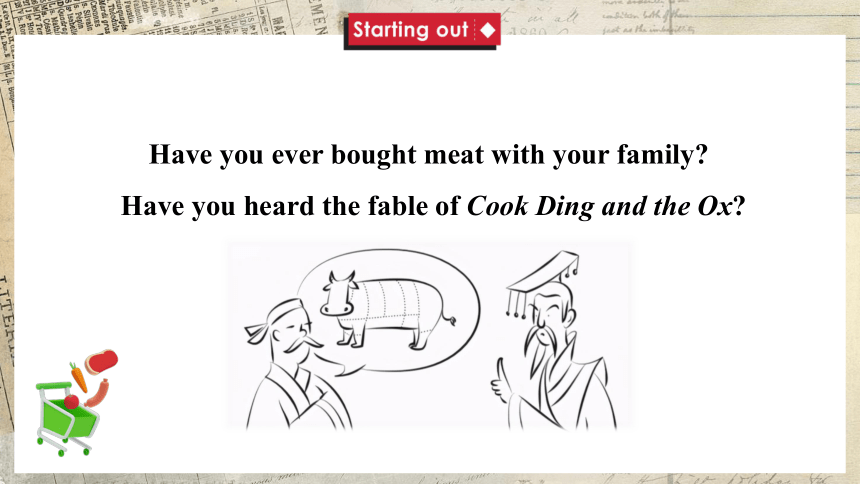
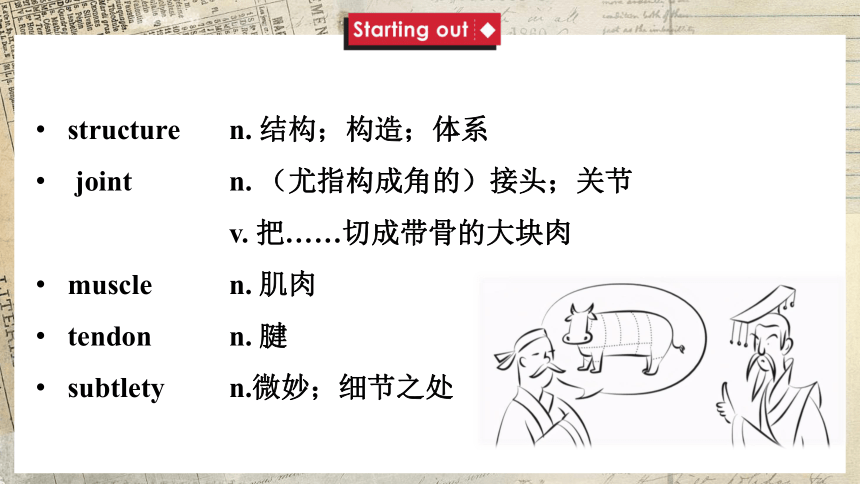

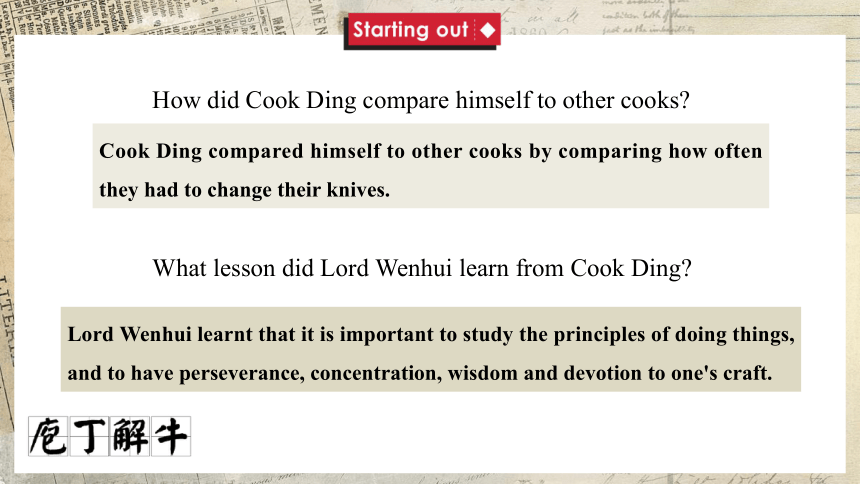
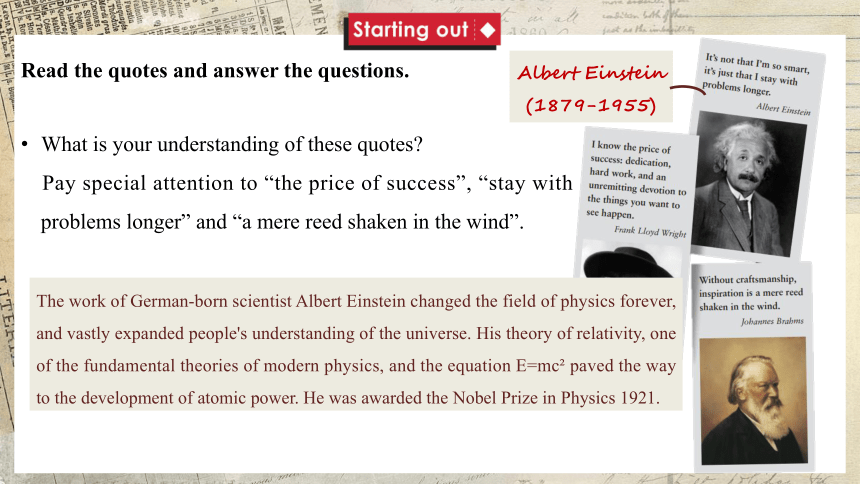
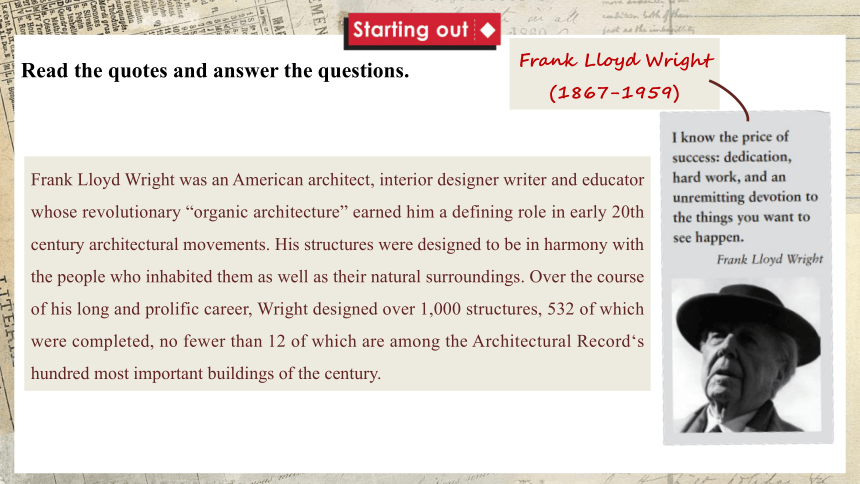
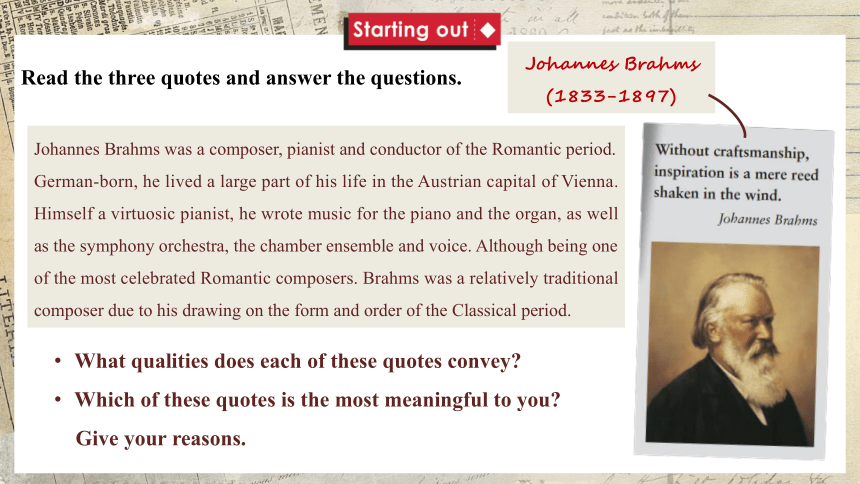

文档简介
Unit 2
A life’s work
Have you ever bought meat with your family?
Have you heard the fable of Cook Ding and the Ox?
structure n. 结构;构造;体系
joint n. (尤指构成角的)接头;关节
v. 把……切成带骨的大块肉
muscle n. 肌肉
tendon n. 腱
subtlety n.微妙;细节之处
Enjoy the video and answer questions.
Take notes if necessary.
How did Cook Ding compare himself to other cooks?
What lesson did Lord Wenhui learn from Cook Ding?
Cook Ding compared himself to other cooks by comparing how often they had to change their knives.
Lord Wenhui learnt that it is important to study the principles of doing things, and to have perseverance, concentration, wisdom and devotion to one's craft.
Read the quotes and answer the questions.
What is your understanding of these quotes?
Pay special attention to “the price of success”, “stay with problems longer” and “a mere reed shaken in the wind”.
The work of German-born scientist Albert Einstein changed the field of physics forever, and vastly expanded people's understanding of the universe. His theory of relativity, one of the fundamental theories of modern physics, and the equation E=mc? paved the way to the development of atomic power. He was awarded the Nobel Prize in Physics 1921.
Albert Einstein
(1879-1955)
Read the quotes and answer the questions.
Frank Lloyd Wright
(1867-1959)
Frank Lloyd Wright was an American architect, interior designer writer and educator whose revolutionary “organic architecture” earned him a defining role in early 20th century architectural movements. His structures were designed to be in harmony with the people who inhabited them as well as their natural surroundings. Over the course of his long and prolific career, Wright designed over 1,000 structures, 532 of which were completed, no fewer than 12 of which are among the Architectural Record‘s hundred most important buildings of the century.
Read the three quotes and answer the questions.
What qualities does each of these quotes convey?
Which of these quotes is the most meaningful to you?
Give your reasons.
Johannes Brahms (1833-1897)
Johannes Brahms was a composer, pianist and conductor of the Romantic period. German-born, he lived a large part of his life in the Austrian capital of Vienna. Himself a virtuosic pianist, he wrote music for the piano and the organ, as well as the symphony orchestra, the chamber ensemble and voice. Although being one of the most celebrated Romantic composers. Brahms was a relatively traditional composer due to his drawing on the form and order of the Classical period.
Look at this picture.
What do you think of the man?
Can you guess his occupation?
Bill Cunningham was an American fashion photographer famous for his candid photography, in particular that taken on thestreets of New York. As a fashion journalistin his early career, his photography caught theattention of an American newspaper, for which he reported from 1978 until his death in 2016. Shunning material wealth throughout his lonand successful life, Cunningham’s philosophy was “If you don’t take their money, they can’t tell you what to do, kid.”
What differences are there between these two photographers?
What do you think they each want to show through their works?
What does the first picture tell you about the photographer
The photographer in the first picture is working on the street with a single, easy-to-carry camera.
The photographer in the second picture is working in a studio with expensive, technologically-advanced equipment.
The first picture tells us about the photographer’s approach to his work and his interest in people’s day-to-day lives.
Activity 1
1. nothing more than
nothing less than
not...anything more than
no more than
no less than
练习:
它只不过是一个杜撰的故事而已。
It is ____________________________ a made-up story.
nothing more than
简直是,极其,不亚于
不过,仅仅
仅仅,只有
多达,不少于
Vocabulary
2. pose
position
positive
a positive attitude
pose as
pose for
pose a threat
练习:The celebrities __________ (pose) for a group photograph before the party.
posed
n. 位置;立场;职位
adj. 积极乐观的;自信的
乐观的态度
冒充;假扮
为……摆好姿势
构成威胁
Vocabulary
3. devotion
devote
devote oneself to
devote one's life to...
devoted
be devoted to (doing) sth.
练习:
_________ (devote) to the study of science, my uncle had little time to take care of his children.
Devoted
v. 致力,献身,倾注
献身于,致力于
把某人的生命奉献于……
adj.挚爱的;忠诚的
致力于(做)某事
Vocabulary
4. approach
an approach to(doing)sth.
adopt/take an approach
the approach of…
练习:
At the meeting they discussed three different ___________ (approach) to the study of mathematics.
approaches
做某事的方法
采用一种方法
……的来临/临近
Vocabulary
5. fascination
have a fascination for/with...
fascinate
fascinating
fascinated
be fascinated by...
练习:This child was ___________ (fascinate) by the plots in the novel.
fascinated
对......十分感兴趣;入迷
v. 深深吸引;迷住
adj. 极有吸引力的;迷人的
adj. 人迷的;极感兴趣的
对……着迷
Vocabulary
Now, read the passage and answer questions.
Activity 1
Choose another suitable title for the passage and give your reasons.
Activity 2
A. Social Butterfly
B. Art and Devotion
C. Follower of Fashion
D. A Life in Photographs
someone who loves to socialise and is outgoing and charismatic
√
1. What made Cunningham so great?
A. His ordinary-looking appearance.
B. His inspiration from ordinary scenes and his hard work.
C. Years of experience in fashion photography.
D. Years of simple life and ability of searching for fun
2. What did Cunningham think of fashion?
A. It was a trend of society.
B. It was a true reflection of people's lives.
C. It was mostly about high society.
D. It was the essence of art coming from life.
√
√
3. What kept Cunningham focused on his craft?
A. The good profit.
B. The love from high society.
C. The lack of self-interest and promotion.
D. The trouble of simple life.
4. What is the main idea of this passage?
A. A life in photographs.
B. Cunningham's early life.
C. The value of fashion.
D. People's world view.
√
√
Organise information from the passage and complete the diagram.
Activity 3
1 high society and big brand
2 the people
3 who they are
4 go out onto the streets of New York
5 he knew he had the right photos
6 took a day off and not once stayed home sick
7 a small apartment with a shared washroom
8 the same meal of sausages, eggs and coffee
9 the benefits offered to him for being a fashion photographer
10 his integrity and would not be bought by anyone
Now come up with five words or expressions to describe Bill Cunningham.
Give your reasons.
Let’s have a discuss!
1 What is your understanding of Bill Cunningham’s words “Money’s the cheapest thing”?
2 Why is Bill Cunningham called a “cultural anthropologist”?
3 What can you learn from Bill Cunningham? Share your thoughts with the class.
4 What text types have you learnt about to help you describe people? If you were to write about Bill Cunningham, which would you choose
Think & Share
Bill Cunningham is called a “cultural anthropologist” because his photography captured and created an everlasting record of the life of New York and its people over half a century.
Learn more about Bill Cunningham
Learn more about Bill Cunningham
Homework
课后拍摄一些你认为生活中美的照片,下节课与大家一起分享。
了解“工匠精神”的含义,搜索关于工匠精神的人物事迹。
See you next class!
A life’s work
Have you ever bought meat with your family?
Have you heard the fable of Cook Ding and the Ox?
structure n. 结构;构造;体系
joint n. (尤指构成角的)接头;关节
v. 把……切成带骨的大块肉
muscle n. 肌肉
tendon n. 腱
subtlety n.微妙;细节之处
Enjoy the video and answer questions.
Take notes if necessary.
How did Cook Ding compare himself to other cooks?
What lesson did Lord Wenhui learn from Cook Ding?
Cook Ding compared himself to other cooks by comparing how often they had to change their knives.
Lord Wenhui learnt that it is important to study the principles of doing things, and to have perseverance, concentration, wisdom and devotion to one's craft.
Read the quotes and answer the questions.
What is your understanding of these quotes?
Pay special attention to “the price of success”, “stay with problems longer” and “a mere reed shaken in the wind”.
The work of German-born scientist Albert Einstein changed the field of physics forever, and vastly expanded people's understanding of the universe. His theory of relativity, one of the fundamental theories of modern physics, and the equation E=mc? paved the way to the development of atomic power. He was awarded the Nobel Prize in Physics 1921.
Albert Einstein
(1879-1955)
Read the quotes and answer the questions.
Frank Lloyd Wright
(1867-1959)
Frank Lloyd Wright was an American architect, interior designer writer and educator whose revolutionary “organic architecture” earned him a defining role in early 20th century architectural movements. His structures were designed to be in harmony with the people who inhabited them as well as their natural surroundings. Over the course of his long and prolific career, Wright designed over 1,000 structures, 532 of which were completed, no fewer than 12 of which are among the Architectural Record‘s hundred most important buildings of the century.
Read the three quotes and answer the questions.
What qualities does each of these quotes convey?
Which of these quotes is the most meaningful to you?
Give your reasons.
Johannes Brahms (1833-1897)
Johannes Brahms was a composer, pianist and conductor of the Romantic period. German-born, he lived a large part of his life in the Austrian capital of Vienna. Himself a virtuosic pianist, he wrote music for the piano and the organ, as well as the symphony orchestra, the chamber ensemble and voice. Although being one of the most celebrated Romantic composers. Brahms was a relatively traditional composer due to his drawing on the form and order of the Classical period.
Look at this picture.
What do you think of the man?
Can you guess his occupation?
Bill Cunningham was an American fashion photographer famous for his candid photography, in particular that taken on thestreets of New York. As a fashion journalistin his early career, his photography caught theattention of an American newspaper, for which he reported from 1978 until his death in 2016. Shunning material wealth throughout his lonand successful life, Cunningham’s philosophy was “If you don’t take their money, they can’t tell you what to do, kid.”
What differences are there between these two photographers?
What do you think they each want to show through their works?
What does the first picture tell you about the photographer
The photographer in the first picture is working on the street with a single, easy-to-carry camera.
The photographer in the second picture is working in a studio with expensive, technologically-advanced equipment.
The first picture tells us about the photographer’s approach to his work and his interest in people’s day-to-day lives.
Activity 1
1. nothing more than
nothing less than
not...anything more than
no more than
no less than
练习:
它只不过是一个杜撰的故事而已。
It is ____________________________ a made-up story.
nothing more than
简直是,极其,不亚于
不过,仅仅
仅仅,只有
多达,不少于
Vocabulary
2. pose
position
positive
a positive attitude
pose as
pose for
pose a threat
练习:The celebrities __________ (pose) for a group photograph before the party.
posed
n. 位置;立场;职位
adj. 积极乐观的;自信的
乐观的态度
冒充;假扮
为……摆好姿势
构成威胁
Vocabulary
3. devotion
devote
devote oneself to
devote one's life to...
devoted
be devoted to (doing) sth.
练习:
_________ (devote) to the study of science, my uncle had little time to take care of his children.
Devoted
v. 致力,献身,倾注
献身于,致力于
把某人的生命奉献于……
adj.挚爱的;忠诚的
致力于(做)某事
Vocabulary
4. approach
an approach to(doing)sth.
adopt/take an approach
the approach of…
练习:
At the meeting they discussed three different ___________ (approach) to the study of mathematics.
approaches
做某事的方法
采用一种方法
……的来临/临近
Vocabulary
5. fascination
have a fascination for/with...
fascinate
fascinating
fascinated
be fascinated by...
练习:This child was ___________ (fascinate) by the plots in the novel.
fascinated
对......十分感兴趣;入迷
v. 深深吸引;迷住
adj. 极有吸引力的;迷人的
adj. 人迷的;极感兴趣的
对……着迷
Vocabulary
Now, read the passage and answer questions.
Activity 1
Choose another suitable title for the passage and give your reasons.
Activity 2
A. Social Butterfly
B. Art and Devotion
C. Follower of Fashion
D. A Life in Photographs
someone who loves to socialise and is outgoing and charismatic
√
1. What made Cunningham so great?
A. His ordinary-looking appearance.
B. His inspiration from ordinary scenes and his hard work.
C. Years of experience in fashion photography.
D. Years of simple life and ability of searching for fun
2. What did Cunningham think of fashion?
A. It was a trend of society.
B. It was a true reflection of people's lives.
C. It was mostly about high society.
D. It was the essence of art coming from life.
√
√
3. What kept Cunningham focused on his craft?
A. The good profit.
B. The love from high society.
C. The lack of self-interest and promotion.
D. The trouble of simple life.
4. What is the main idea of this passage?
A. A life in photographs.
B. Cunningham's early life.
C. The value of fashion.
D. People's world view.
√
√
Organise information from the passage and complete the diagram.
Activity 3
1 high society and big brand
2 the people
3 who they are
4 go out onto the streets of New York
5 he knew he had the right photos
6 took a day off and not once stayed home sick
7 a small apartment with a shared washroom
8 the same meal of sausages, eggs and coffee
9 the benefits offered to him for being a fashion photographer
10 his integrity and would not be bought by anyone
Now come up with five words or expressions to describe Bill Cunningham.
Give your reasons.
Let’s have a discuss!
1 What is your understanding of Bill Cunningham’s words “Money’s the cheapest thing”?
2 Why is Bill Cunningham called a “cultural anthropologist”?
3 What can you learn from Bill Cunningham? Share your thoughts with the class.
4 What text types have you learnt about to help you describe people? If you were to write about Bill Cunningham, which would you choose
Think & Share
Bill Cunningham is called a “cultural anthropologist” because his photography captured and created an everlasting record of the life of New York and its people over half a century.
Learn more about Bill Cunningham
Learn more about Bill Cunningham
Homework
课后拍摄一些你认为生活中美的照片,下节课与大家一起分享。
了解“工匠精神”的含义,搜索关于工匠精神的人物事迹。
See you next class!
